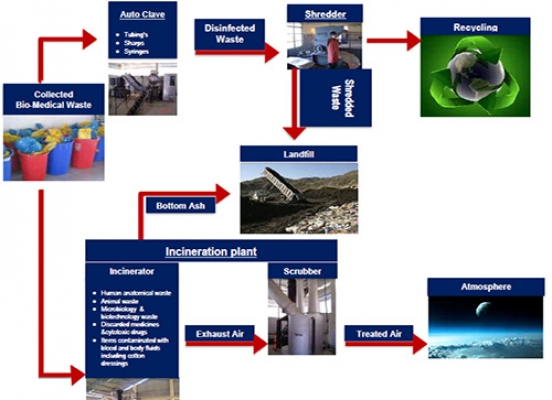Biomedical Waste Management Process
There is a big network of Health Care Institutions in India. The hospital waste like body parts, organs, tissues, blood, and body fluids along with soiled linen, cotton, bandage, and plaster casts from infected and contaminated areas are very essential to be properly collected, segregated, stored, transported, treated, and disposed of safely to prevent nosocomial or hospital-acquired infection.
- Waste collection
- Segregation
- Transportation and storage
- Treatment & Disposal
- Transport to final disposal site
- Final disposal
- Pharmaceuticals
- Pressurized containers

Biomedical Waste Treatment and Disposal
Health care waste is a heterogeneous mixture, which is very difficult to manage as such. But the problem can be simplified and its dimension reduced considerably if a proper management system is planned.
Incineration Technology
This is a high-temperature thermal process employing combustion of the waste under the controlled condition for converting them into inert material and gases. Incinerators can be oil-fired or electrically powered or a combination thereof. Broadly, three types of incinerators are used for hospital waste: multiple hearth type, rotary kiln, and controlled air types. All the types can have primary and secondary combustion chambers to ensure optimal combustion. These are refractory lined.
Non-Incineration Technology
Non-incineration treatment includes four basic processes: thermal, chemical, irradiative, and biological. The majority of non-incineration technologies employ thermal and chemical processes. The main purpose of the treatment technology is to decontaminate waste by destroying pathogens. Facilities should make certain that the technology could meet state criteria for disinfection.

Autoclaving
-
- The autoclave operates on the principle of the standard pressure cooker.
- The process involves using steam at high temperatures.
- The steam generated at high temperature penetrates waste material and kills all the microorganism
- These are also of three types: Gravity type, Pre-vacuum type, and Retort type.
In the first type (Gravity type), the air is evacuated with the help of gravity alone. The system operates at a temperature of 121 deg. C. and steam pressure of15 psi. For 60-90 minutes. Vacuum pumps are used to evacuate air from the Pre-vacuum autoclave system so that the time cycle is reduced to 30-60 minutes. It operates at about 132 deg. C. Retort-type autoclaves are designed with much higher steam temperature and pressure. Autoclave treatment has been recommended for microbiology and biotechnology waste, waste sharps, soiled and solid wastes. This technology renders certain categories (mentioned in the rules) of bio-medical waste innocuous and unrecognizable so that the treated residue can be landfilled.
Microwave Irradiation
- The microwave is based on the principle of the generation of high-frequency waves.
- These waves cause the particles within the waste material to vibrate, generating heat.
- This heat generated from within kills all pathogens.
Chemical Methods
- 1 % hypochlorite solution can be used for chemical disinfection
Plasma Pyrolysis
Plasma pyrolysis is a state-of-the-art technology for the safe disposal of medical waste. It is an environment-friendly technology, which converts organic waste into commercially useful byproducts. The intense heat generated by the plasma enables it to dispose of all types of waste including municipal solid waste, biomedical waste, and hazardous waste safely and reliably. Medical waste is pyrolyzed into CO, H2, and hydrocarbons when it comes in contact with the plasma-arc. These gases are burned and produce a high temperature (around 1200oC).
To know more, please check Medicare.

